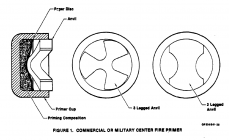RegionRat
Gold $$ Contributor
Not going to change the gross pressure issue one way or the other. However, that isn't the issue.Is the depth you seat the primer at going to make any of this 50,000 PSI go away? I am not sure but setting it deeper may be worse, wiggle room may let the prime move more than it should.
Primers are designed to have the anvil in contact, plus+, Not slack.
Even when seated compressed, that the cup will slide back in the pocket up to the bolt face, and then the head moves there as well to bring the cup to flush, and this is normal.
I do not recommend seating primers exactly flush to the head or zero depth to avoid the movement of the primer cup since the firing pin strike will also move it, but in this condition the erratic performance will not make you happy.
ETA: If you are not convinced, go ahead and run a special test. Not every system is fine enough to resolve the issues, but many are. Take velocity stats and see what happens with the primer at zero depth, and then compare to samples that have the anvils touching to compressed about 0.000" to 0.002" and compare. I wouldn't ever recommend a zero depth seating for a semi auto for safety reasons, but a special test in a bolt gun while being very careful should be low risk.
Last edited:











